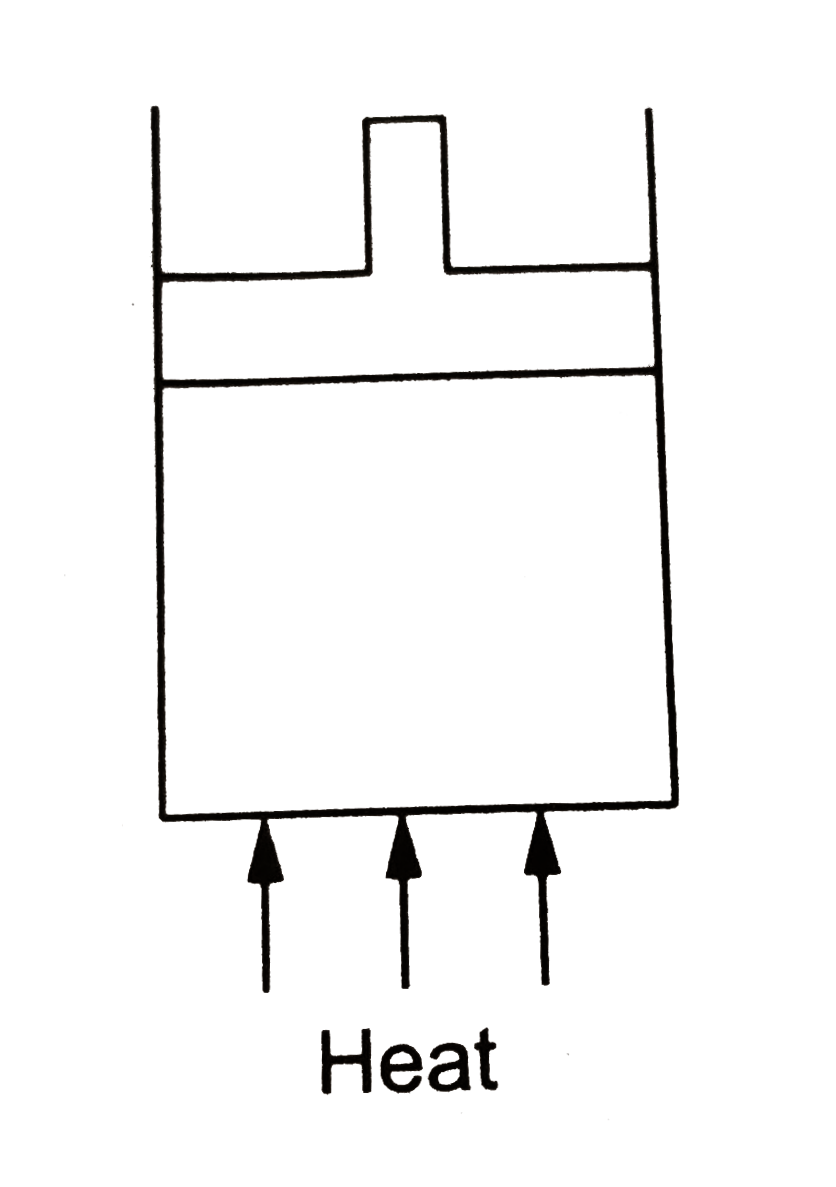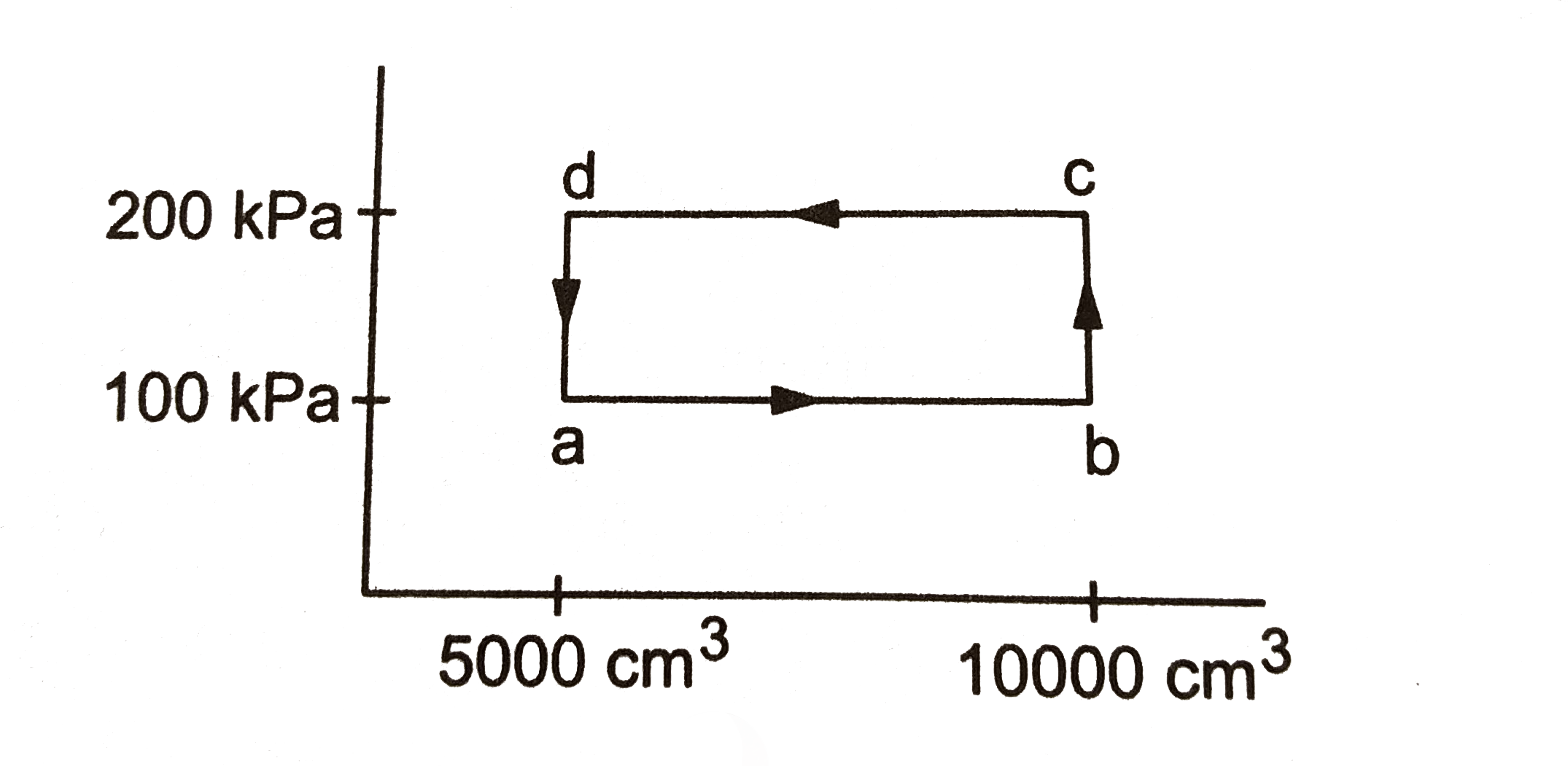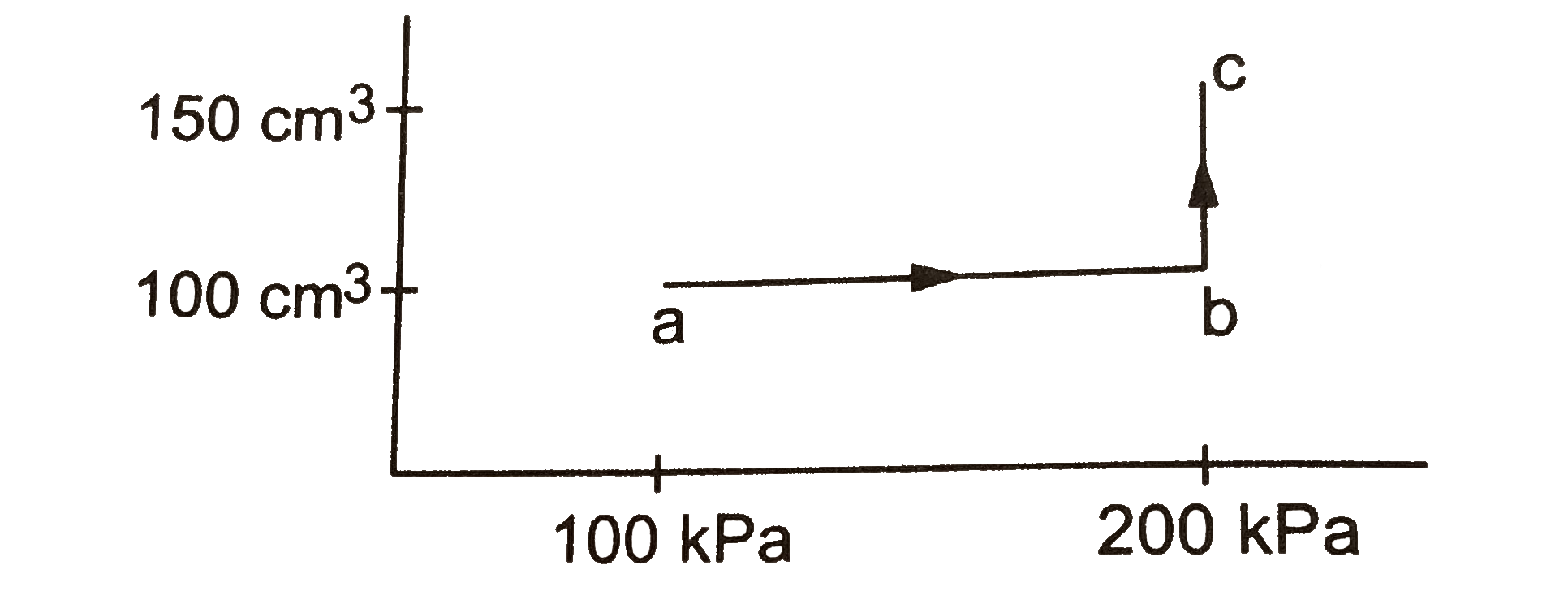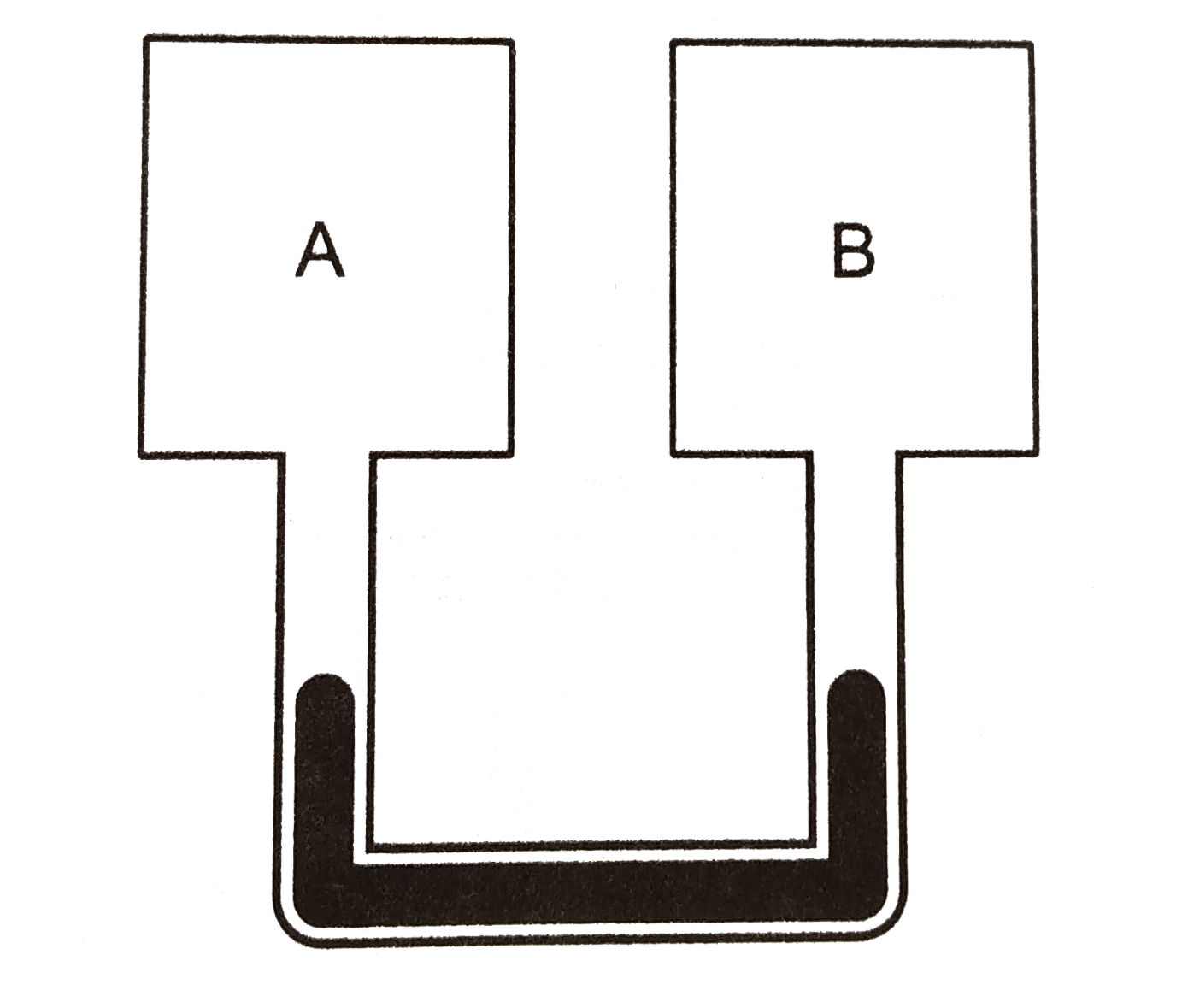Complete Solutions to Exercises of chapter SPECIFIC HEAT CAPACITIES OF GASES of Class 11 book with complete answers and questions
| Class 11 | PHYSICS |
| Chapter | SPECIFIC HEAT CAPACITIES OF GASES |
| HC VERMA | Exercises |
| Number Of Questions | 35 |
| Academic Year | 2023-24 |
A vessel containing one of mole of a monatomic ideal gas `(molecular weight = 20 g mol_^(1))` is moving on a floor at a speed of `50 m s^(-1)` The vessel is stopped suddenly. Assuming that the mechanical energy lost has gone into the internal energy of the gas , find the rise in its temperature .
View Solution`5g` of a gas is contained in a rigid container and is heated from `15^@C to 25^@C` . Specific heat capacity of the gas at constant volume is `0.172 cal g ^(-1)^@C^(-1)` and the mechanical equivalent of heat is 4.2 J cal . Calculate the change in the internal energy of the gas.
View SolutionFigure shows a cylindrical container containing oxyegn `(gamma = 1.4)` and closed by a 50 kg frictionless piston. The area of cross section is `100cm(2)` , atmospheric pressure is `100 kPa`+E2 and g is 10 m s^(-2)`. The cylinder is slowly heated for some time. Find the amount of heat supplied to gas if the piston moves out through a distsnce of 20 cm.
 .
.
View SolutionThe specific heat capacities of hydrogen at constant volume and at constant pressure are `2.4 cal g^(-1) ^@C ^(-1) and 3.4 cal g^(-1)^@C` respectively. The molecular weight of hydrogen is `2g mol^(-1)` and the gas constant `R= 8.3 xx 10^(7)erg^@C mol^(-1)` . Calculate the value of `J`.
View SolutionThe ratio of the molar heat capacities of an ideal gas is `(C_p / C_v 7/6)`. Calculate the change in internal energy of 1.0mole of the gas when its temperature is raised by `50 k (a)` keeping the pressure constant , (b) keeping the volume constant and (c ) adiabatically.
View SolutionA sample of air weighing `1.18 g` occupies `1.0 xx 10^(3) cm^(3)` when kept at `300 K and 1.0 xx 10^(5)` pa. When `2.0 cal` of heat is added to it constant volume, its temperature increases by `1^@C`. Calculate the amount if heat needed to increases the temperature of air by `1^@C` at constant pressure if the mechanical equivalent of heat si `4.2 xx 10^(-1)` . Assume that air behaves as an ideal gas.
View SolutionAn ideal gas expands from `100 cm^(3) to 200 cm^(3)` at a constant pressure of `2.0 xx 10^(5)` when `50 J` of heat is supplied to it. Calculate (a) the change in internal energy of the gas , (b) the number of moles in the gas if the initial temperature is 300K , (C ) the molar heat capacity `C_P` at constant pressure and (d) the molar heat capacity `C_v` at constant volume
View SolutionAn amount of heat is added to a monatomic ideal gas in a process in which the gas performs work `Q/2` on its surrounding. Find the molar heat capacity for the process.
View SolutionAn ideal gas is taken through a process in which the pressure and the volume are changed according to the equation `p=kv`. Show that the molar heat capacity of the gas for the process is given by `(C=C_v + ( R)/(2)`.
View SolutionAn ideal gas `(C_p / C_v = gamma)` is taken through a process in which the pressure and volume vary as `(p = aV^(b)`. Find the value of b for which the specific heat capacity in the process is zero.
View SolutionTwo ideal gases have same value of `(C_p / C_v = gamma)`. What will be the value of this ratio for a mixture of the two gases in the ratio `(1:2)`?
View SolutionA mixture contains 1 mole of helium `(c_p = 2.5 R, C_v 1.5 R. )` and 1mole of hydrogen `(C_p = 3.5 R, C_v = 2.5 R, )` . Calculate the values of `C_p , C_v and gamma` for the mixture.
View SolutionHalf mole of an ideal gas `(gamma = 5/3) is taken through the cycle abcda as shown in figure . Take `(R = 25/3 JK^(-1) mol^(-1))`. (a) Find the temperature of the gas in the staes a, b, c and d. (b) Find the amount of heat supplied in the processes ab and bc. (c ) Find the amount of heat liberated in the processes `cd and da`.

View SolutionAn ideal gas `(gamma = 1.67 )` is taken through the process abc shown in figure . The temperature at the point a is `300 k`. Calculate (a) the temperature at b and c, (b) the work done in the process, ( c) the amount of heat supplied in the path ab and in the path bc and (d) the change in the internal energy of the gas in the process.

View SolutionIn Joly's differential steam calorimeter, `3g` of an ideal gas is ccontained in a rigid closed sphere at `20^@C`. The sphere is heated by steam at `100^@C` and it is found that an extra `0.095 g` of steam has condensed into water as the temperature of the gas becomes constant. Calculate the specific heat capacity of the gas in `(Jg^(-1) K^(-1).` The latent heat of vaporization of `water = 540 cal g ^(-1)`.
View SolutionThe volume of an ideal gas `(gamma 1.5 )` is changed adiabatically from 4.00 liters to 3.00 liters . Find the ratio of (a) the final pressure to the initial pressure and (b) the final temperature to the initial temperature.
View SolutionAn ideal gas at pressure` 2.5 xx 10^(5)` `pa` and temperture `300k` occupies `100 cc`. It is adiabatically compressed to half its original volume. Calculate (a) the final pressure, (b) the final temperature and ( c) the work done by the gas in the peocess. Take `(gamma = 1.5)`.
View SolutionAir `(gamma = 1.4 )` is pumped at 20atm pressure in a motor tyre at `20^@C`. If the tyre suddenly bursts, what would be the temperature of the air coming out of the tyre. Neglect any mixing with the atmoshpheric air.
View SolutionA gas is enclosed in a cylindrical can fitted with a piston. The walls of the can and the piston are adiabatic. The initial pressure , volume and temperture of the gas are `100 kpa, 400cm^(3)` and `300k` respectively. The ratio of the specific heat capacities of the gas is `(C_p / C_v = 1.5)` Find the pressure and the temperature of the gas if it is (a) suddenly compressed (b) slowly compressed to 100 cm^(3).
View SolutionThe initial pressure and volume of a given mass of a gas `(C_p / C_v = gamma)` are `(p_0) and (V_0). The gas can exchange heat with surrounding. (a) It is slowly compressed to a volume `(V_0 / 2 )` and then suddenly compressed to `(V_0 /4)` . Find the final pressure. (b) If the gas is suddenly cpmpressed from the volume `(V_0 to V_0 / 2 )` and then slowly compressed to `(V_0 / 4 )`, What will be the final pressure?.
View SolutionConider a given sample of an ideal gas `(C_p / C_v = gamma )` having initial pressure `(p_0) and volume (V_0)` . (a) The gas is isothermally taken to a pressure `(P_0 / 2 )` and from there adiabatically ta a pressure `(p_0 / 2) and from there isothermally to a pressure `(p_0 / 4 )` . find the volume.
View SolutionA given sample of an ideal gas `(gamma = 1.5 )` is compressed adiabatically from a volume of `150 cm ^(3)` to `50 cm ^(3)`. The initial pressure and the initial temperature are `150 kpa` and `300K`. Find (a) the number of moles of the gas in the sample, (b) the molar heat capacity at constant volume, (c) the final pressure and temperature, (d) the work done by the gas in the process and (e) the change in internal energy of the gas .
View SolutionThree samples A, B and C of the same gas `(gamma = 1.5)` have equal volumes and temperatures. The volume of each sample is doubled, the process being isothermal for A, adiabtic for B and isobaric for C. If the final pressures are equal for the three samples, Find the ratio of the initial pressures.
View SolutionTwo samples A and B of the same gas have equal volumes and pressures . The gas is sample A is expanded isothermally to double its volume and the the gas in B is expanded adibatically to double its volume . If the work done by the gas is the same for the two cases, show that gamma satisfies the equation`(1-2 ^(1-gamma)= (gamma - 1 ) 1n2`.
View Solution1 liter of an ideal gas `(gamma =1.5)` at `300k` is suddenly compressed to half its original volume. (a) Find the ratio of the final pressure to the initial pressure. (b) If the original pressure is `100 kpa`, find the work done by the gas in the process. (c) What is the change in internal energy? (d) What is the final temperature? (e) the gas is now colled to `300k` keeping its pressure constant. Calculate the work done during the process . (f) The gas is now expanded iasothermally to achive its original volume of 1 liters. Calculate the work done by the gas .(g) Calculate the total work done in the cycle.
View SolutionFigure shows a cylindridcal tube with a adibatic walls and fitted with an adiabatic separtor. The separator can be slid into the tube by an external mechanism. An ideal gas`(gamma=1.5)` is injected in the two sides at equal pressures and temperatures . The separator remains in equilibrium at the middel. It is now slid to a position where it divides the tube in the ratio 1:3 Find the ratio of the tempertures in the two parts of the vessel.

View SolutionFigure shows two rigid vessels A and B, each of volume `200 cm ^(3)` containg an ideal gas `(C_v = 12.5 JK ^(-1) mol^(-1))`. The vessels are connected to a manometer tube containing mercury. The pressure in both the vessels is 75 cm mercury and the temperature is 300k. (a) `(5-0 J)` of heat is supplied to the gas in the vessels.(b) `(10 J)` to the gas in the vessels B. Assuming no appreciable transfer of heat from A to B calculate the dufference in the heights of mercury in the two sides of the manometer. Gas constant `(R = 8.3 JK^(-1) mol^(-1))`

View SolutionFigure shows two vessels with adiabatic walls, one containing 0.1 g of helium `(gamma =1.67 , M = 4 g mol^(-1))` and the other containing some amount of hydrogen `(gamma = 1.4, M = 2 g mol^(-1))`. Initially , the temperatures of the two gases are equal. The gases electrically heated for some time during which equal amounts of heat are given to the gases. It is found that the temperatures rise through the same amount in the two vessels. Calculate the mass of hydrogen.

View SolutionTwo vessels A and B of equal volume `(V_0)` are connected by a narrow tube which can be closed by a value. The vessels are fitted with piston which can be moved to change the volumes. Initially, the valve is open and the vessels contain an ideal gas `(C_p / C_v = gamma )` at atomspheric pressures`(P_0)` and atmoshpeheric temperature `(T_0)`. The walls of the vessels A are diathermic and those of B are adiabatic. The value is now closed and the pistons are slowly pulled out to increase the volumes of the of the vessels to dobuled the original value.(a) Find the temperatures and pressures in the two vessels. (b) The value is now opened for sufficeint time so that the gases acquire a common tempertures and pressures . Find the new values of the temperatuere and the pressures.
View SolutionFigure shows an adiabatic cylindrical tube of volume `(V_0)` divided in two parts by a frictionless adibatic separator . Initially, the separator is kept in the middle, an ideal gas at pressure `(p_1)` and the temperatures `(T_1)` is injected into the left part and the another ideal gas at pressures `(P_2)` and temperature `(T_2)` is injected into the right part. `(C_p / C_v = gamma)` is the same for both the gases. The separator is slid slowly and is released at a position where it can stay in equilibrium. Find (a) the volumes of the parts, (b) the heat given to the gas in the left part and (c) the final common pressure of the gases.

View SolutionAn adibatic cylindrical tube of cross-sectional area `1 cm^(2)` is closed at one end fitted with a piston at the other end. The tube contains `0.03 g` of an ideal gas . At 1 atm pressure and at the temperture of the surrounding, the length of the gas column. The pressure of the gas falls to `0.355 atm`. Find th speed of sound in the gas at atmospheric temperture.
View SolutionThe speed of sound in hydrogen at `0^@c` is `1280 m s^(-1)`. The density of hydrogen at STP is `0.089 kg m^(-3)`. Calculate the molar heat capacities `(C_p and C_v)` of hydrogen.
View Solution`4.0 g of helium occupies 22400 cm^(3)` at STP. The specific heat capacity of helium at constant pressure is `( 5.0 cal K^(-1) mol ^(-1))`. Calculate the speed of sound in helium at STP.
View SolutionAn ideal gas having density `1.7 xx 10^(-3) g cm ^(-3) at a preesure` 1.5 xx 10^(5) ` pa is a filled Kundt tube. When the gas is resonnated at a frequency of 3.0 kHz, nodes an formed at a separation of 6.0 cm . Calculate the heat molar heat capacites `(C_p and C_v)` of the gas.
View SolutionStanding waves of frequency `5.0 kHz` are produced in a tube filled with oxygen at `300k`. The separation between the consecutive nodes is `3.3 cm`. Calculate the specific heat capacities `(C_p and C_v)` of the gas.
View Solution
Exercises questions and complete solutions for chapter SPECIFIC HEAT CAPACITIES OF GASES of HC VERMA PHYSICS (HINGLISH) of Class 11